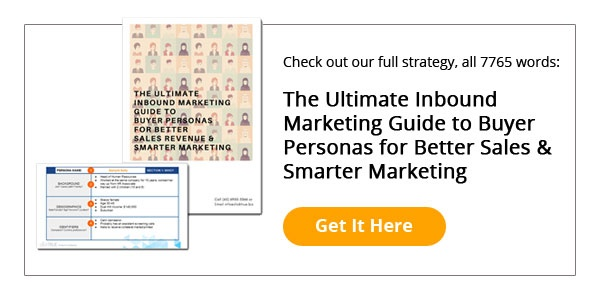
When you speak to your customers and ask them for feedback on your product, service, website or brand, do they always give you positive feedback? Not always. Some customers will only give you negative feedback, because of several reasons: they know they will never use your product or service, they are truly dissatisfied with your company and what it offers, they had bad experiences before or it just boils down to preference, a general feeling or downright malicious intent.
It’s always important to know why and what better way than to form a negative buyer persona to truly ensure your teams identify these customers and know how to deal with them properly and professionally.
What you do with the negative feedback eventually matters, because they can provide you with a good springboard to hone the rough edges off the buyer persona that you’re developing. It’s like developing the opposite mirror of your positive, or traditional buyer persona, and knowing the signals to avoid if you ever encounter these persona traits in your campaign endeavors.
Well, that’s where building the negative buyer persona helps. By harnessing negative feedback from negative customers, you can build up and strengthen your eventual traditional buyer persona that will be used for your inbound marketing campaigns.
The reason why you should listen to negative feedback, or to put it bluntly, negative customers, is that these customers are definitely part of a set of personas that should be taken seriously and definitely not ignored. By knowing what would never work with negative buyer personas, you can use their feedback and the negative persona you create to reduce acquisition costs, avoid a costly reputational risk and save your inbound marketing campaigns from targeting the wrong groups of customers.
Identify what is a Negativity Persona First
The first thing you have to do is to identify what makes up a negative persona. It’s different from what some might call a traditional persona. A traditional persona is the kind of persona that gives you the best data points, the optimum results and opposes you the least. The data points you collect from your customers range from what they do every day, how frequent they face their challenges, why they buy certain things, the things they are always querying and the inconveniences they face in life.

Buyer personas give you the ability to decide how many resources to allocate, attract leads and convert them to buy your product or service. They are the very people you’re in business for because they are the lifeblood of why your company exists.
Negative personas on the other hand, define what you definitely should avoid, and save your company time and money as you do not want to sell and publicize your products or services to them. By knowing who your negative personas are and the negative feedback they give, you can sift out the true customer and buyer persona so that they do not strain your marketing efforts.
1. Feedback from your Internal Departments
When you first talk to your internal departments, such as your sales and marketing teams, you’d probably want everyone to share the same wavelength. However, it is always useful to ask them to provide you with negative information about the customer data points and discussions they’ve had.
They can include items like:
-
Leads that brought you nowhere, and the strategies that failed
-
The pages that your leads dropped off on
-
The items that were left abandoned at the shopping cart
-
The complaints that were passed on to customer support or sales
At some point, when you’ve developed a negative buyer persona, and you encounter customers who fit the profile, it’s often better to sever ties with these prospects rather than spend time and reputation to continuously engage with them.
2. Validating Negative Feedback from Your Customers
Sometimes, the negative feedback you’ve gotten from your internal teams may not be enough. The best way to validate if the feedback is genuine is to interview your customers. Perhaps find customers who have stopped buying from you, or the ones who have been complaining to your helpline or your support emails.
Another method, though a little more effort required, is to find and speak with the negative customers you’ve previously surveyed. The questions can include why they gave a low satisfaction score, why they stayed within your funnel long enough to register as a positive lead but never really bought your product or service in the end. It’s like that same customer you see every day walking into your shop browsing your items, checking prices, spending 5-10 minutes just looking, and then walking out, not buying anything. It’s always a good idea to find out why he’s loyal, he’s persistent but not engaging and converting. Another example is a customer who’s been downloading your free app on his mobile phone, using it daily, but never buying the in-app items despite logging in almost daily.

As you speak to a number of these customers, you may begin to spot a trend or pattern in their responses, giving you a general ‘negative voice’ that may begin to take shape in the negative buyer persona. An example of that customer who’s been visiting your shop consistently but not buying anything, could he be doing market research for someone else, or he’s just interested in the product but doesn’t have the funds to spend on it? The customer who’s been using your app daily but not spending on in-app items could be someone who’s into free stuff (normally termed as a freeloader) and would never spend a single cent buying a USD0.99 cent in-app item but is fine with splurging USD299.99 on gadgets.
3. Crafting the Negative Persona
Now that you’ve spoken to your internal and external customers, looked at the data points and saw the trendlines, you can build your negative buyer persona. The baseline is often the basic demographics, like age, gender, family background, and then identifiers like goals, challenges and traits. You’d probably want to flesh out your negative buyer persona by chronicling his or her daily activities, the good intentions that didn’t happen and lead to pet peeves, the satisfactions that may lead to dissatisfactions and the compliments that eventually led to complaints.
Identifiers are good guides to see if any goals, challenges and traits may lead to a problematic customer, within which you would document in your negative buyer persona, whom you may name as Dissatisfied Daniel or Suspicious Susan.

Once you’ve gotten your negative buyer personas, you can then use them as a guide to identify customers who fall into this persona. The pattern will eventually appear and your teams will know them when they show up. However, do not make the mistake of assuming that this pattern will persist permanently as customers change, either through an experience, an epiphany or something that is out of your control. When this happens, that customer may no longer fit your negative buyer persona, but instead fall into one of your positive or traditional buyer personas.



 hello@clicktrue.biz
hello@clicktrue.biz
 info.my@clicktrue.biz
info.my@clicktrue.biz info.th@clicktrue.biz
info.th@clicktrue.biz info.id@clicktrue.biz
info.id@clicktrue.biz info.vn@clicktrue.biz
info.vn@clicktrue.biz




